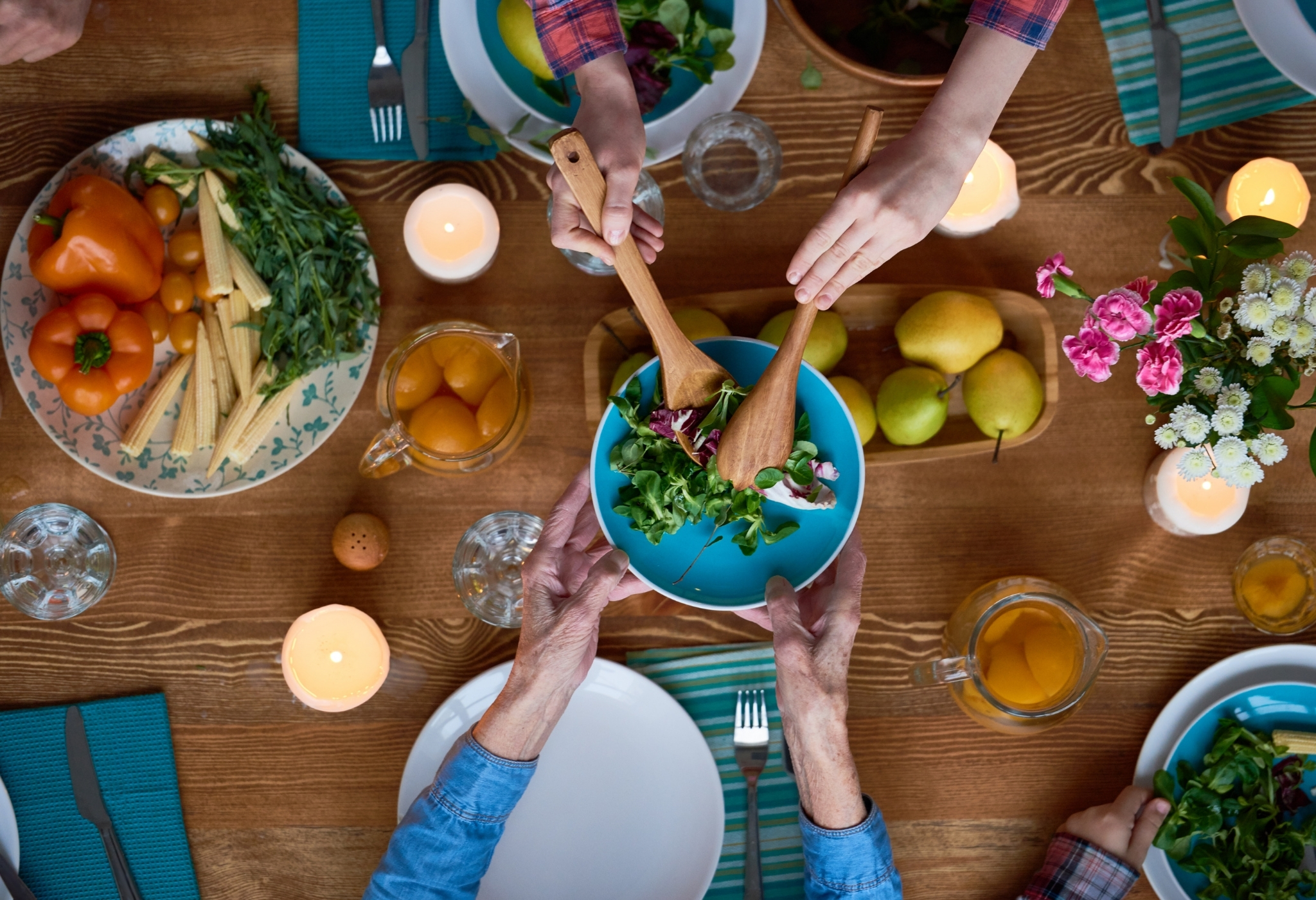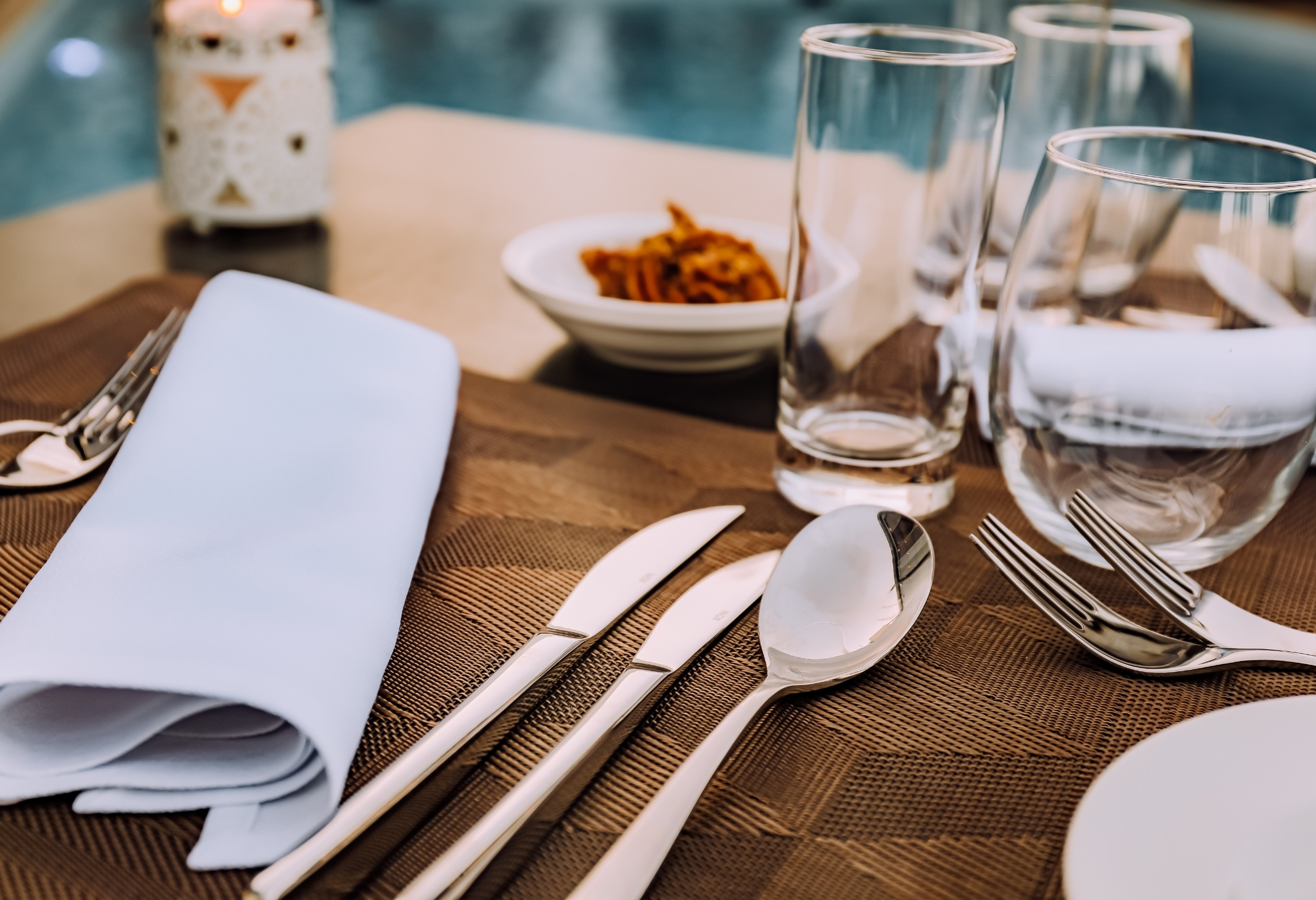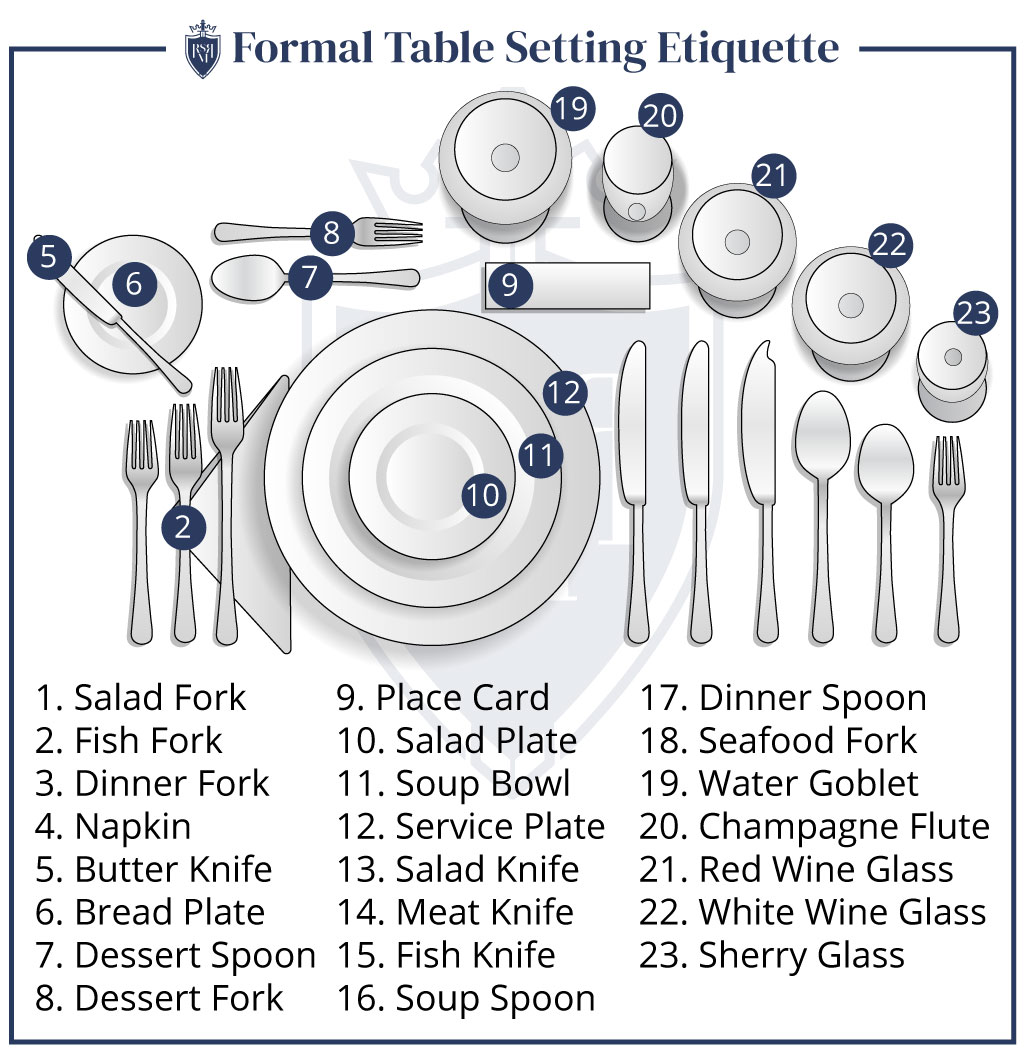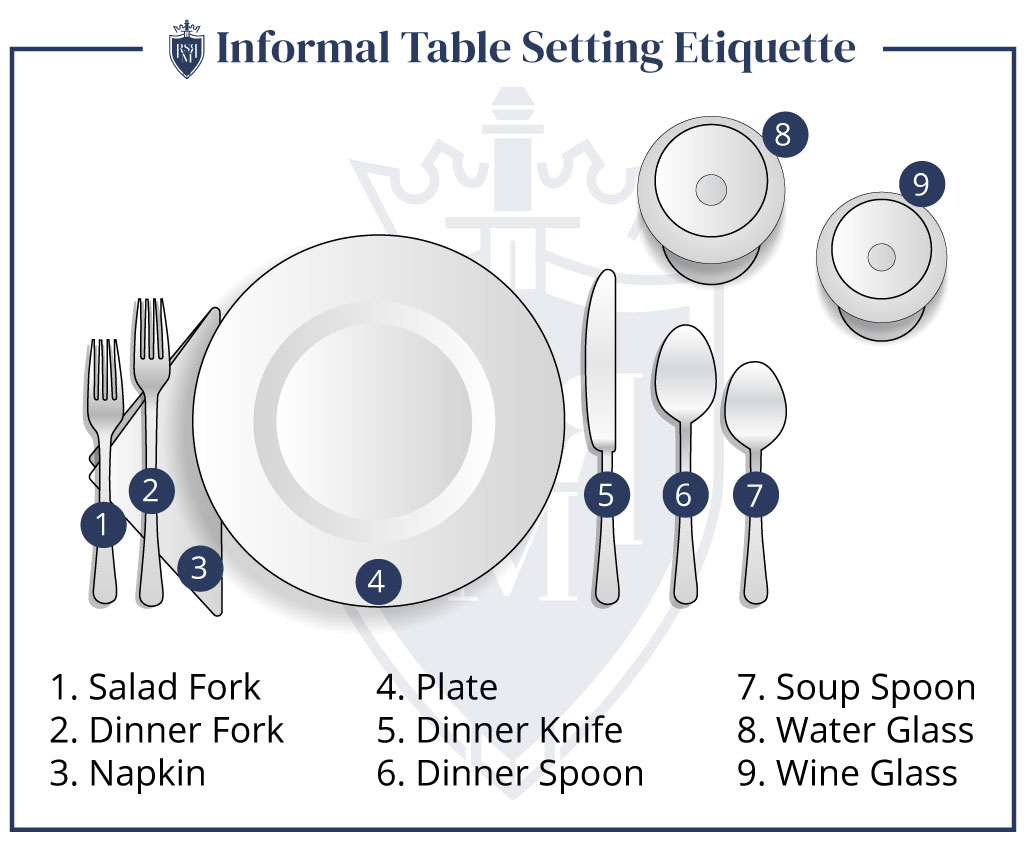Sharing meals is an important bonding ritual, and it's often the gateway to making important connections.
But without good table manners, you could blow your chance of building that relationship with your date, your interviewer, your client, or your fiancee's parents.
And you could embarrass yourself at business, social, and even family gatherings.
In this article, we'll show you the dining rules you need to know so that you can enjoy your meal without worrying you're making a fool out of yourself.
- What Is Dining Etiquette
- Basic Table Manners
- Dining Etiquette Starts Before You Get To The Table
- You Still Need Table Manners When There's NO Table
- Place Setting Basics
- Sitting Down And Leaving The Table
- Napkin Etiquette Rules
- How To Order And Taste Wine
- When To Start Eating?
- How To Eat Politely
- Saying No To Food And Drink
- Bonus: Who Pays For Dinner?
Before We Get Started: What Is Dining Etiquette?

- Etiquette is how you handle yourself in society.
- Manners are the rules of polite behavior (part of etiquette).
So table manners (following the rules) are a part of dining etiquette (how you contribute to everyone’s enjoyment of the meal). Here are the ten most important ones.
Today's article is sponsored by HelloFresh. Get mouthwatering seasonal recipes and fresh, pre-measured ingredients delivered right to your door with America's #1 meal kit delivery service. HelloFresh offers a wide variety of quick meal options, like 20-minute dinners or oven-ready pizzas. They also make living healthy easier with many Low-Cal, Carb-Smart, Vegetarian, and Pescatarian options every week!

You can save up to 30% by using HelloFresh versus grocery store shopping. Click here and use code RMRS14 for up to 14 FREE MEALS across your first 5 HelloFresh boxes plus free shipping!
#1. Basic Table Manners
Pay attention to your hosts. If in doubt, copy them, and don’t start eating until they do.
Don’t chew with your mouth open or talk with food in your mouth. Take small bites so you can finish them before speaking.
Bring your food to your face, not your face to your food. It's a plate, not a trough.
“Please” and “thank you” are still the magic words. “Excuse me” will take you equally far.
Best way to make good conversation? Really listen to people. Keep it simple and fun, and avoid emotional topics: disgust, anger, fear, and sadness have no place at the table. Nor do your negative opinions about your host's lasagna or choice of wine.
#2. Dining Etiquette Starts Before You Get To The Table

You're invited to a dinner party. Fantastic! They're a lot of fun and are quite often an opportunity to make a good impression on an influencer or two: your girlfriend's father, the new Chairman of the Board, etc.
Surely you don't want to sabotage your chances before your host has even finalized the menu? Here's how to prevent that from happening.
RSVP within 3 days of receiving an invitation.
Dress on the smart side of appropriate for the occasion: it shows respect for your hosts and fellow guests, and of course it's always a far better choice to be overdressed than underdressed. The former is also easier to remedy: you can leave your blazer and tie in the cloakroom, but you can't drive home once you've arrived and realized you're the only man there without one.
If you’re visiting someone’s home, bring a small gift, such as chocolates, a kitchen gadget, or wine. Be on time, but not more than 5 minutes early: chances are, your hosts will still be in the middle of last-minute preparations.
Before you walk in, turn your phone OFF. Don't just put it on silent, and don't have it in sight during the meal. This not only shows respect for your hosts and fellow guests, it also helps YOU to be fully present and enjoy the meal.
#3. You Still Need Table Manners When There's NO Table
Picnics, buffets, and barbecues may be informal, but even at such casual occasions, there are a few dining etiquette rules to keep in mind to make sure everyone has a good time.
Care for other people's comfort in social situations is, after all, the mark of a true gentleman, even when the occasion calls for sandals and tiki torches.
- Take an average-sized serving. Don't hog the food. Gluttony is not attractive, especially to the hungry people in line behind you who saw you take the last two cheeseburgers. You can always go back for seconds once everyone has eaten.
- Don’t double-dip. If you want to dip your chip more than once, put some dip on your plate and spare everyone else your saliva.
- Cut meat for yourself. If you're handy with a carving knife, offer to help those nearby. But don't cut the whole roast. Leaving cut-up meat lying around will dry it out.
- Most importantly, clean up after yourself. This is especially important when your hostess is Mother Nature.
#4. Table Setting – The Basics

It looks daunting, but the rules for plates, glasses and silverware are actually quite simple. During the meal, start with the silverware on the outside and work your way inward. Knives and spoons go on the right, forks on the left.
If there's also a small fork on the right, that's for seafood. Silverware at the top of the plate (often a smaller spoon) is for dessert. Your butter knife should be on or near your bread plate.
Bread plates are on the left, drinking glasses on the right. If you get confused as to which is yours and which is your neighbor's, make a “b” for bread and “d” for drink by touching the thumb and index finger of each hand (subtly… maybe under the table.)
Your water glass is the one above the knife in an informal place setting. It's usually bigger than your wine glass.

The shape of a wine glass tells you not only what to put in it, but how to hold it. Red wine glasses are broader because you hold them by the bowl to keep the wine warm. You hold a white wine glass by the stem to keep it cool.
#5. Sitting Down And Leaving The Table
Find your place at a table either by looking for your name card or waiting for the host or wait staff to seat you. Don’t sit until the host does.
On social occasions, be ready to help ladies next to you with their chairs. Don't do this on business occasions: in business, the proper way to treat a woman is as a fellow professional.
If you need to leave the table during the meal, say “Excuse me for a second. I'll be right back.” No further explanation is necessary.
After the meal, wait for the host to stand up before leaving the table.
#6. Napkin Etiquette Rules
Place your napkin in your lap within one minute of sitting down. Don't tuck it into your trousers or shirt: it's not a bib. Unfold it just enough to cover your lap.
The main purpose of a napkin is not to catch dropped food but to unobtrusively keep your mouth clean. Dab, don't wipe: it's very bad dining etiquette to use your napkin as a towel.
Whenever you stand, loosely fold your napkin and place it to the left of your plate.
#7. How To Order And Taste Wine

This is one bit of dining etiquette that causes a lot of guys' anxiety, but again, it's actually quite simple when you know how. First, ask your companion(s) whether they want individual glasses or a bottle, and their likes and dislikes:
- Red or white
- Old World (earthy) or New World (fruity)
- Full-bodied (thick and heavy), medium-bodied, or light-bodied
- Any particular varieties they don't like.
Traditionally, red wine goes with heavier dishes, such as beef or pork, white wine with lighter fare like chicken or fish. However, it is perfectly all right to order whichever you prefer, regardless of what you're eating.
Avoid the ‘house white' or ‘house red' (they're usually terrible) but don't be afraid to get the cheapest named wine on the menu. The second cheapest is usually overpriced because restaurateurs know how people's minds work.
If you wish, ask the server or sommelier for a recommendation. Tell them what you're looking for, point to a bottle on the menu in your price range and say ‘I'm considering a bottle like this.
This is a universal restaurant code for “This is exactly what I want to pay, but I don't want to say it out loud.”
When presented with a bottle of wine, check the label and the cork (including the vintage) to make sure it's what you ordered. The waiter will then pour you a small amount.

Look, swirl, sniff, and taste. This is NOT to see if you like the wine. If you don't, tough luck: you've bought it. It's to see whether it's corked (tainted with a fungus that grows on corks).
If your wine smells like mold or wet cardboard, it's corked and you should tell the server. They'll be happy to replace it.
#8. When To Start Eating?
There are two parts to this rule.
- Wait to eat till the host picks up their fork. It's bad dining etiquette to be seen eating alone.
- The exception to part 1. Don't let hot food get cold. If hot food is being served and people are still milling around, start eating after two other people have been served. If you're all seated and there are more than four in the group, start when three or four other guests have been served.
On a slightly touchy note, acknowledge tradition and prayer, regardless of your own religious beliefs. You needn't cross yourself or fold your hands, even if everyone else does, but do show respect and keep quiet.
A prayer before eating should be initiated only by the host but can be said by anyone.
You needn't feel any guilt about politely refusing to say it if the host asks you to. A simple “Thank you, I'd rather not” will suffice. If you're willing to, keep it short and simple, bearing in mind the very real possibility that there is more than one faith present.
#9. How To Eat Politely
Keep your elbows OFF the table when food is ON it. It's perfectly good dining etiquette to rest your elbows on the table between courses or during coffee.
Avoid reaching into others' personal space or standing to reach something. Ask someone to pass it.
If you spill something, apologize quickly and concisely, and do what you can to help with cleanup. Then relax and do your best to forget about it.
You can tip a bowl of soup to get the last few spoonfuls but tip it AWAY from yourself. Forgetting this rule can lead to that quite unpleasant ‘soup down your suit' feeling.
Place your knife and fork in the 4:20 position when finished. This tells the server they can clear your plate, and makes it easy for them to pick it up without dropping the silverware.
#10. Saying No To Food And Drink
Offered something that you just don't want? Take a small amount, and try one bite.
Allergies? Vegetarian? Kosher? Any other dietary restrictions? It is your job to let your host know your needs in advance, ideally when you RSVP. If your needs can't be met, eat a large meal beforehand, and if it's a meat issue, eat PROTEIN.
If you're expecting your hosts to offer alcohol, decide how you're going to respond.
Will you have just one drink? Two? Or none? It is your decision and it requires no explanation. But whatever you decide, be consistent. It'll make people respect you more and accept your decision more easily.
If you don't want to drink, but people are toasting, take one glass and just touch it to your lips. It's also correct dining etiquette to toast using water or soft drinks, although some groups will accept this more easily than others. Just don't raise an empty glass.
Bonus Question: Who Pays For Dinner?

For business meals, the person who issued the invite pays. If that’s you, don’t ask for contributions. If it’s not you, don’t offer.
Social events may be paid for by the host or split among guests. Have enough cash (including some small bills for tipping) just in case.
Don’t expect a woman to chip in for dinner on the first few dates, but if she really wants to, let her. (And don’t pay behind her back when she’s asked you not to: you want her to trust you.)
What's the best action step you can take to learn good dining etiquette? Practice it consistently at home, and not just if you have a family. Even if you live alone, practice your table manners until they become second nature. That way, they'll always be there when you need them.
Good table manners aren't a means of impressing people. They're an important part of a gentleman's main job, which is to make the world a more pleasant and comfortable place for those around him.
Click below to watch the video – 7 IMPRESSIVE Dining Etiquette Skills EVERY Man Must Master!
The post 10 Dining Etiquette Rules Every Man Must Know appeared first on Real Men Real Style.
